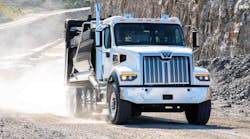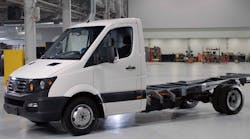Both Class 8 and trailer sales are expected to peak this year and start steadily declining thereafter, according to analyst projections made here at the annual FTR Transportation Conference.
“Class 8 order activity, which was really strong in the fourth quarter of 2014, is now normalized,” noted Eric Starks, FTR’s president.
“There’s still replacement demand and capacity utilization in at 90%, well above the 85% to 88% range where equipment needs to be added to the fleet, suggesting a little upside,” Starks (at right) emphasized.
“But when you examine economically-derived demand, it indicates softening demand for equipment," he added. "By the time we get to the end of 2016, we should be back in line with normal production levels.”
Starks projected that the total Class 8 build across North America should top out between 325,000 to 330,000 units for 2015 – up from 295,000 units in 2014. By 2016, though, total Class 8 production should dip to 290,000 units, with further declines to 260,000 units in 2017 and to between 220,000 and 225,000 units for 2018.
Starks added that truck tonnage is expected to increase 3% next year, which should help bolster what should be a “relatively stable sales environment” for the Class 8 market in 2016.
Michael Baudendistel – VP with Wall Street investment firm Stifel Financial Corp., formerly Stifel Nicolas & Co. – characterized 2015 as “the last great year” for Class 8 sales as the market will reach its “cyclical peak.”
He believes the drop-off in North American Class 8 builds will be a little steeper, falling from 330,000 units this year to 280,000 units in 2016, 260,000 units in 2017, and 220,000 units in 2018.
Baudendistel also does not expect a “pre-buy” to occur in the Class 8 segment ahead of the implementation of Phase II greenhouse gas (GHG) mandates for heavy-duty trucks.
“There’s a great difference between the EPA [Environmental Protection Agency] emission reduction rules and the GHG rules,” he explained. “The GHG rules are directly tied to fuel economy improvements, so the sooner they reach the market, the better.”
Where trailers are concerned, FTR’s Don Ake (at right) noted that total North American production should decrease at a more rapid clip compared to the Class 8 market.
Total trailer builds should top 302,400 units this year, compared to 265,300 units in 2014, then decline 10% to 273,000 units in 2016 and 225,000 units in 2017.
Ake added that several specific types of trailers are currently witnessing outsized demand, especially refrigerated models, which are expected to exceed 45,600 total units for 2015 – beating the old record of 39,450 units set back in 1999.
Dump trailers and dry vans models are also “hot,” he added, with both experiencing big order backlogs and a strong build pace.
One “wild card” for the trailer forecast is the addition of extra trailer production capacity, Ake said, with four new plants coming on line over the next two years; boosting trailer build capacity by 20,000 units in 2016 and eventually to 40,000 units by 2017.
Still, Ake “expects a soft landing this time” for the trailer market after a sustained level of demand.
“This is the sixth year of a five year up-cycle,” he said. “This is the longest trailer up-cycle in history. It’s a peculiar situation; it’s never happened before.”








